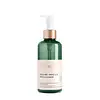What's inside
What's inside
 Key Ingredients
Key Ingredients

No key ingredients
 Benefits
Benefits

 Concerns
Concerns

 Ingredients Side-by-side
Ingredients Side-by-side

Water
Skin ConditioningAloe Barbadensis Leaf Juice
Skin ConditioningCocamidopropyl Hydroxysultaine
CleansingGlycerin
HumectantSodium Cocoyl Isethionate
CleansingDisodium Coco-Glucoside Citrate
EmulsifyingSqualane
EmollientCocoyl Proline
Skin ConditioningMoringa Oleifera Leaf Extract
Skin ConditioningRosmarinus Officinalis Leaf Oil
MaskingCymbopogon Schoenanthus Oil
MaskingPelargonium Graveolens Oil
MaskingSalvia Sclarea Oil
MaskingHydrolyzed Pea Protein
EmollientMedicago Sativa Extract
TonicSodium Levulinate
Skin ConditioningCaramel
Cosmetic ColorantMagnesium Chloride
Potassium Sorbate
PreservativeSodium Gluconate
Skin ConditioningCitric Acid
BufferingCitral
PerfumingCitronellol
PerfumingLinalool
PerfumingWater, Aloe Barbadensis Leaf Juice, Cocamidopropyl Hydroxysultaine, Glycerin, Sodium Cocoyl Isethionate, Disodium Coco-Glucoside Citrate, Squalane, Cocoyl Proline, Moringa Oleifera Leaf Extract, Rosmarinus Officinalis Leaf Oil, Cymbopogon Schoenanthus Oil, Pelargonium Graveolens Oil, Salvia Sclarea Oil, Hydrolyzed Pea Protein, Medicago Sativa Extract, Sodium Levulinate, Caramel, Magnesium Chloride, Potassium Sorbate, Sodium Gluconate, Citric Acid, Citral, Citronellol, Linalool
Water
Skin ConditioningSodium Cocoyl Isethionate
CleansingGlycerin
HumectantGlycol Distearate
EmollientLauryl Betaine
CleansingAcrylates Copolymer
Panthenol
Skin ConditioningSorbitan Olivate
EmulsifyingSpirulina Platensis Extract
Skin ProtectingPortulaca Oleracea Extract
Skin ConditioningVigna Radiata Seed Extract
Skin ConditioningArtemisia Vulgaris Extract
Skin ConditioningRhodomyrtus Tomentosa Fruit Extract
HumectantSpinacia Oleracea Leaf Extract
Skin ConditioningBrassica Oleracea Italica Extract
AstringentCentella Asiatica Extract
CleansingButylene Glycol
HumectantDextrin
AbsorbentArginine
Masking1,2-Hexanediol
Skin ConditioningCaprylyl Glycol
EmollientGlyceryl Caprylate
EmollientEthylhexylglycerin
Skin ConditioningPhytosteryl/Octyldodecyl Lauroyl Glutamate
Skin ConditioningAllantoin
Skin ConditioningCarthamus Tinctorius Flower Extract
Skin ConditioningGardenia Florida Fruit Extract
Skin ConditioningHydroxyacetophenone
AntioxidantMethylpropanediol
SolventTocopherol
AntioxidantPropanediol
SolventSodium Chloride
MaskingCitric Acid
BufferingWater, Sodium Cocoyl Isethionate, Glycerin, Glycol Distearate, Lauryl Betaine, Acrylates Copolymer, Panthenol, Sorbitan Olivate, Spirulina Platensis Extract, Portulaca Oleracea Extract, Vigna Radiata Seed Extract, Artemisia Vulgaris Extract, Rhodomyrtus Tomentosa Fruit Extract, Spinacia Oleracea Leaf Extract, Brassica Oleracea Italica Extract, Centella Asiatica Extract, Butylene Glycol, Dextrin, Arginine, 1,2-Hexanediol, Caprylyl Glycol, Glyceryl Caprylate, Ethylhexylglycerin, Phytosteryl/Octyldodecyl Lauroyl Glutamate, Allantoin, Carthamus Tinctorius Flower Extract, Gardenia Florida Fruit Extract, Hydroxyacetophenone, Methylpropanediol, Tocopherol, Propanediol, Sodium Chloride, Citric Acid
 Reviews
Reviews

Ingredients Explained
These ingredients are found in both products.
Ingredients higher up in an ingredient list are typically present in a larger amount.
Citric Acid is an alpha hydroxy acid (AHA) naturally found in citrus fruits like oranges, lemons, and limes.
Like other AHAs, citric acid can exfoliate skin by breaking down the bonds that hold dead skin cells together. This helps reveal smoother and brighter skin underneath.
However, this exfoliating effect only happens at high concentrations (20%) which can be hard to find in cosmetic products.
Due to this, citric acid is usually included in small amounts as a pH adjuster. This helps keep products slightly more acidic and compatible with skin's natural pH.
In skincare formulas, citric acid can:
While it can provide some skin benefits, research shows lactic acid and glycolic acid are generally more effective and less irritating exfoliants.
Most citric acid used in skincare today is made by fermenting sugars (usually from molasses). This synthetic version is identical to the natural citrus form but easier to stabilize and use in formulations.
Read more about some other popular AHA's here:
Learn more about Citric AcidGlycerin is already naturally found in your skin. It helps moisturize and protect your skin.
A study from 2016 found glycerin to be more effective as a humectant than AHAs and hyaluronic acid.
As a humectant, it helps the skin stay hydrated by pulling moisture to your skin. The low molecular weight of glycerin allows it to pull moisture into the deeper layers of your skin.
Hydrated skin improves your skin barrier; Your skin barrier helps protect against irritants and bacteria.
Glycerin has also been found to have antimicrobial and antiviral properties. Due to these properties, glycerin is often used in wound and burn treatments.
In cosmetics, glycerin is usually derived from plants such as soybean or palm. However, it can also be sourced from animals, such as tallow or animal fat.
This ingredient is organic, colorless, odorless, and non-toxic.
Glycerin is the name for this ingredient in American English. British English uses Glycerol/Glycerine.
Learn more about GlycerinSodium cocoyl isethionate is a natural ingredient from coconut oil. It is an ultra gentle cleanser that gives a nice foam without drying the skin or impacting the skin barrier.
The amount of foam created depends on the amount of sodium cocoyl isethionate used in the product.
This ingredient also helps improve the spreadability of a product.
Learn more about Sodium Cocoyl IsethionateWater. It's the most common cosmetic ingredient of all. You'll usually see it at the top of ingredient lists, meaning that it makes up the largest part of the product.
So why is it so popular? Water most often acts as a solvent - this means that it helps dissolve other ingredients into the formulation.
You'll also recognize water as that liquid we all need to stay alive. If you see this, drink a glass of water. Stay hydrated!
Learn more about Water